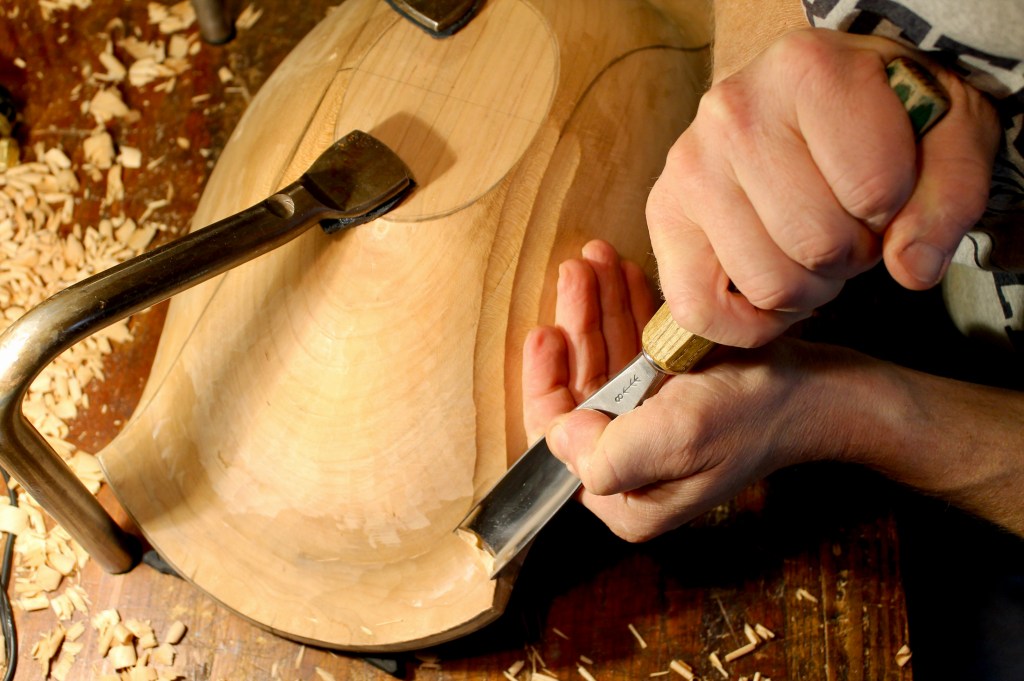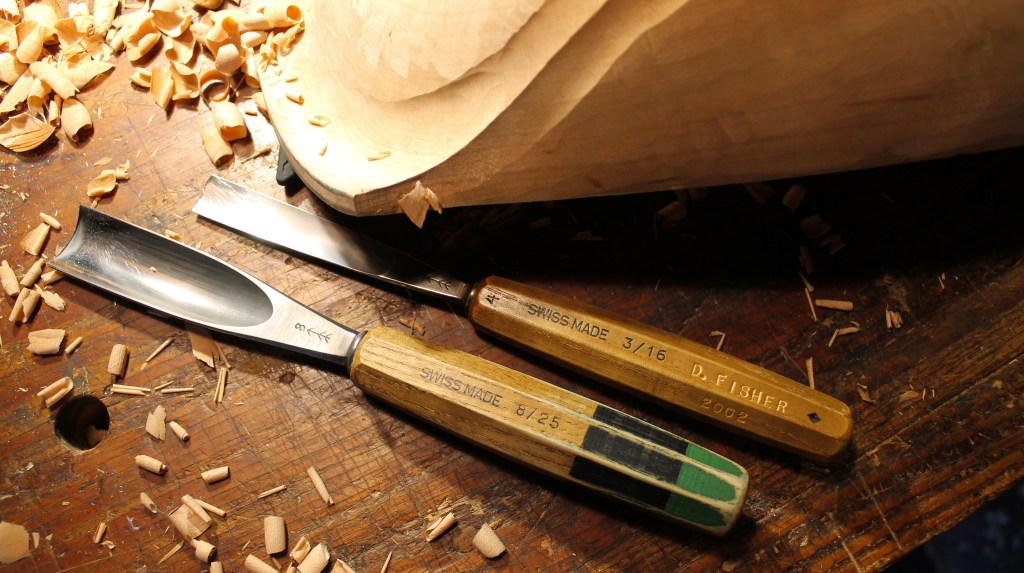
Mullet, D.A., rattail, fade, French braid — there are many options for what to do with the hair on the back of your head. Likewise for the outside of a bowl. Maybe it’s because my own hair situation provides me with so few options that I get creative with the bowls. Ridiculous theories and connections aside, on bowls with oval feet, I often carve a raised curved line that flows from one handle to the other, as seen on the cherry bowl above that I finished a few weeks ago.

Another cherry bowl, above, was ready for the final dry carving of the surfaces when I took the photo recently. It sits there after drying, with the overall form already established during the green carving stage. The line is just sketched on in pencil, descending there from the lower corner of the near handle. I snapped a few more photos as I went about carving it.

As usual, at this stage, I secure the bowl on the bench with holdfasts. Then, with body pressure, I use a shallow gouge (a #3 16mm in this case) to carve a flute to each side of the pencil line.

As I near the handle, I switch to a steeper and wider gouge (in this case a #8 25mm) to merge the flute into the concave area under the handle without the corners of the gouge digging in.

These are the gouges. The specifics aren’t important. Lots of other combinations would work, and much depends on the form and proportions of the individual bowl.

So, at this stage, the line is now established and it’s time to merge the raised areas to either side with the surrounding surfaces.

Here, I’m doing that with a wide double-bevel chisel, keeping the corner free of the wood in the previously carved flute. You could do this with a wide single bevel chisel as well, I just prefer the touch and control of the bevel geometry provided by the double bevel in this case.

Same on the other side.

Then it looks like this. Could be refined more, depending on the final surface texture. In this case, the final gouge surface cuts will do the final blending of the form just as in the example in the first photo.
By the way, these recent bowls have all been for commissions, but I’m gaining on it and hope to finish up some other pieces soon that I’ll be able to post for sale.
And I’m still searching for a good name,for ease of reference, for this design feature. Something less cumbersome than “Curved line flowing across the outside of the bowl from handle to handle.” Suggestions are welcome!

Very helpful, David. Could this step be done while it is still green or would that create another problem?
LikeLiked by 1 person
To do it during the green stage would make the most sense if you plan on just leaving the surface as is from the green stage rather than going back to it after drying. This step doesn’t require the removal of much wood, so doing it in dry wood isn’t tough. You could certainly rough out the general idea when green though.
LikeLiked by 1 person
The exterior raised line seems to closely fit the definition of a “swage line” or character line from automobile design terminology – when cars had so much more character in their form.
Also a contour line would closely fit that particular raised feature.
Your artistry is phenomenal. I hope you’ll consider writing a book in the near future combining your sketches, processes, and thoughts that go into your art.
LikeLiked by 1 person
Belt Line. That’s what they call such a thing on cars. ..And since the belt usually follows the shape of the belly it supports… 🙂
Love the bowls!
LikeLiked by 1 person
“Character line” is another possibility from car design…https://en.wikipedia.org/wiki/Glossary_of_automotive_design
LikeLiked by 1 person
On my turned bowls I call that kind of line a shadow line.
LikeLiked by 1 person
Belt line is a good one! I was thinking flow line…
LikeLiked by 1 person
How about ‘crescent’ line or ‘arabesque’ line?
LikeLiked by 1 person
oh yeah I like the poetic crescent or arabesque suggestion–
LikeLiked by 1 person
As always, wonderful work and great article/post, thank you for taking the time to post it online.
Unfortunately, these days my “belt line” reflects this shape, time for a diet before the overhanging porch becomes a basement.
LikeLiked by 1 person
On a boat, that line would be called a chine
LikeLiked by 1 person
Wow! Thanks to all of you for the great ideas. Including a couple other ideas I received through emails, the list looks something like this:
keelson line
belt line
shadow line
rhumb line
flow line
crescent line
arabesque line
I was completely unfamiliar with some of these terms, so it was fun and enlightening to research them. Any would work well. I’ll sleep on it, but I’m leaning toward belt line, although, from what I can gather, the belt line of a car runs just under the side windows and “character lines” are below that. https://i.pinimg.com/originals/c6/e8/4b/c6e84ba7e6322b1f660faa816d42eea3.jpg
I have little interest in motors and fast cars, but I have always been drawn to the idea of those clay cars with designers scraping away at them to achieve the form.
LikeLike
The Marilyn Monroe. Sort of reminds me of her iconic picture.
LikeLiked by 1 person
You mean with the dress over the vent, or Andy Warhol’s portrait?
LikeLike
Yep! Dips in the middle and flairs up on the sides.
LikeLike
The dress over the vent, where it dips in the middle and flats up on the sides.
LikeLike
That’s what I thought you were referring to. What a cool and imaginative connection. Thanks!
LikeLike
Reminds me of the ocean tide line.
Very helpful post.
LikeLiked by 1 person
or tide line or tidal line…which is forever changing…
LikeLike
I like that image. I see what you mean with the flow of the tide. Wonderful.
LikeLike
Hi Dave, For a one word descriptor I would use “contour”. A contour is a sinuous line, which also has the connotation of separating different curves or elevations, such as on a topographic contour map.
LikeLiked by 2 people
Fits in well with my love of maps, Larry. Thank you.
LikeLike
These are all so good. Some of these suggestions, I think I can use when referring to other aspects of bowls. For example, keelson/kelson line seems perfect for the raised line running fore and aft along the interior of most of the ale bowls I’ve carved.
Some others have been added now:
chine
countour line
swage line
character line
and even the Marilyn Monroe! Love that thought.
Many are fitting for the situation in some respects. I like the boat connection with chine, but that might be better when there is a more significant change in the angles of the form at the line. Contour line, flow line, shadow line all make sense. If I roll with the car design connection for now, I think the line formed by the intersection of the rim and the exterior side would be the belt line and this line formed below would be a swage line or character line (which are types of contour and shadow lines I suppose).
One way or another, I’m learning a ton. Thanks again to all!
LikeLike
Thanks for breaking this technique. I’ve lost sleep wondering how you did it! 😆
LikeLiked by 1 person
Sweet dreams, Chris.
LikeLike
Sticking with the haircut analogy I will humbly suggest “weight line”.
LikeLiked by 1 person
Way to bring it around! Thanks. I’ve cut my own hair for years, but I don’t think I have a weight line.
LikeLike
I’d call it a swale! As in ditch & swale method, also from landscaping
LikeLike
And now landscaping! I shouldn’t be surprised at all of the interconnections in esthetics and design applications, but I love seeing them pointed out like this.
LikeLike
Can you call it simply the “flow line”?
LikeLike
I do like that, and Emil mentioned it above too. In fact, I’ve done a few zoom presentations to some groups recently around the theme of flow in and through greenwood carving, so the idea of referring to such a line as a flow line resonates with me.
LikeLike
To me it looks most like the swooping lines on a boat that mark the waterline—a few above called out chine, which is a ridge between the sides and bottom of some boats. Lots of things on boats have interesting names. I learned that the space above the waterline is called the freeboard. Below is the draft line.
What about calling it the Swoop? Swoopline?
Beautiful work as always. Shame on you (and kudos) for making artistry look so easy. That smaller gouge has seen a few sharpenings!
LikeLiked by 1 person
Pingback: Walnut Salad - Peter Bernhardt Woodcraft